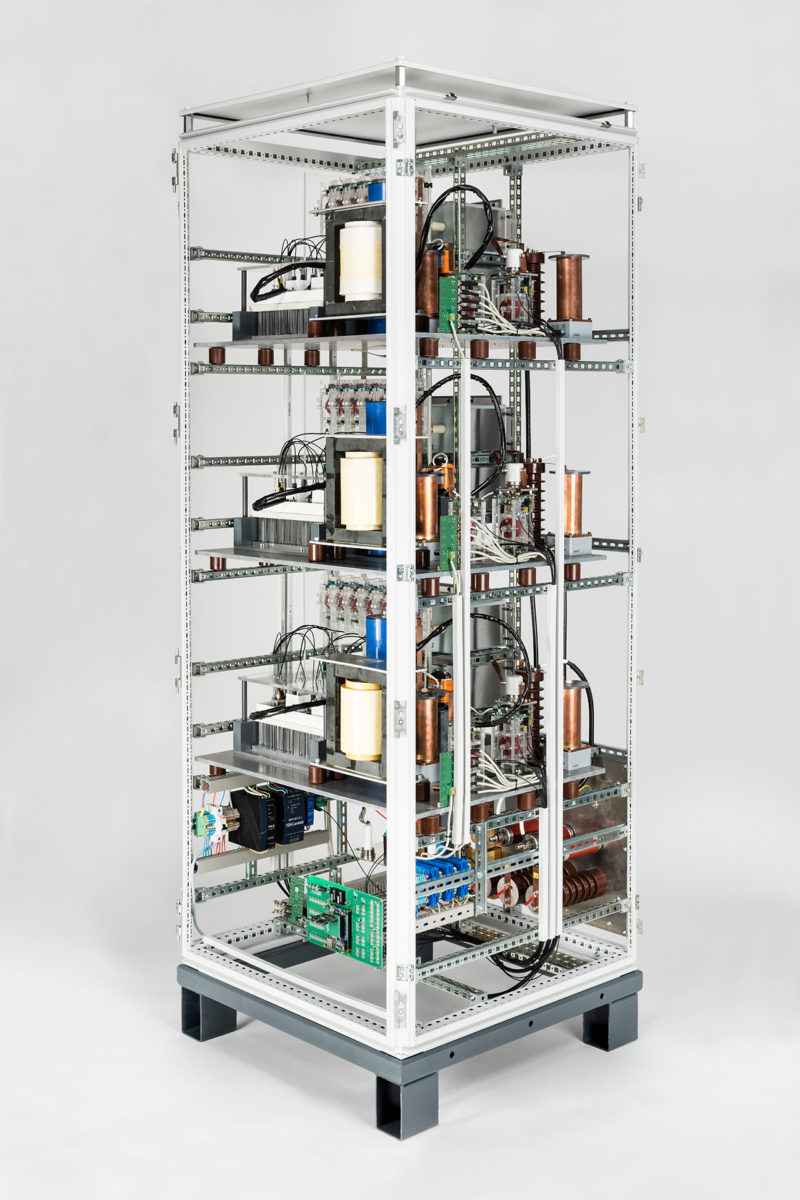Fraunhofer's three-phase inverter uses high-voltage silicon carbide (SiC) transistors, enabling the inverter to be connected to the medium voltage grid without the need for an additional transformer. By regulating reactive power and filtering undesirable harmonics in the electricity grid, the inverter contributes to the stabilization of power grids with a high share of renewables. While other means of harmonics filtering exist, high-voltage applications such as this are said to be more effective than those working at lower voltages and which require a 50Hz transformer.
Currently, power electronics are coupled to the electricity grid mainly in a low voltage range. For grid stabilization, STATCOMs – static synchronous compensator – power converters supply continuous inductive or capacitive reactive power. Coupling to the medium voltage grid is thus affected by a 50 Hz transformer.
Fraunhofer's product can feed directly into the medium voltage grid without a transformer, due to the use of high voltage transistors made of silicon carbide (SiC). Component prototypes with a blocking voltage of 15 kV were used for the purpose.
Commercially available silicon transistors have a blocking voltage of 6.5 kV, requiring more complicated component structures with a higher number of components and increased architectural complexity – with more failure points – as a result. A further advantage of the new technology is that the transistors can work with higher frequencies, due to lower switching energy requirements, and post lower power losses than regular silicon transistors, resulting in better control dynamics of the inverter. Due to the higher frequency, the inverter can act as an active filter to compensate for harmonics in the medium-voltage grid. With STATCOMS this is only possible to limited extent, because of the low-pass effect of the 50 Hz transformer.
Popular content
“The use of high-blocking SiC transistors, however, also presents us with new challenges,” says Project Head Dirk Kranzer. “The transistors switch very fast. The extremely steep rate of voltage rise during switching can cause faults or lead to partial or creeping discharges in the insulation. In developing the circuitry, large efforts must be made to minimize these undesirable effects. Before commercial implementation is possible, further technological developments are necessary, for example, in the power modules or in the inductive and capacitive components.”
The demonstrator for feed-in to the 10 kV grid has a power of 100 kVA. The frequency is 16 kHz – approximately ten times higher than in medium-voltage converters based on silicon semiconductors. Advanced high-voltage (15 kV/10 A) silicon carbide power MOSFETs were used for the transistors. The inductive components were developed by the company and project partner Spezial-Transformatoren-Stockach GmbH (STS).
Besides stabilizing the medium-voltage grid, other possible applications for high-voltage silicon carbide components exist. “For power electronics, we see a large potential for future applications in the medium-voltage range,” says Prof. Dr. Bruno Burger, Group Head of New Components and Technologies at Fraunhofer ISE. “In the future, totally new system architectures for renewable power plants – for example, large photovoltaic plants or wind farms in the megawatt range – are conceivable. The new technology also shows promise for applications in the railroad industry or large battery storage banks.”
This content is protected by copyright and may not be reused. If you want to cooperate with us and would like to reuse some of our content, please contact: editors@pv-magazine.com.



By submitting this form you agree to pv magazine using your data for the purposes of publishing your comment.
Your personal data will only be disclosed or otherwise transmitted to third parties for the purposes of spam filtering or if this is necessary for technical maintenance of the website. Any other transfer to third parties will not take place unless this is justified on the basis of applicable data protection regulations or if pv magazine is legally obliged to do so.
You may revoke this consent at any time with effect for the future, in which case your personal data will be deleted immediately. Otherwise, your data will be deleted if pv magazine has processed your request or the purpose of data storage is fulfilled.
Further information on data privacy can be found in our Data Protection Policy.